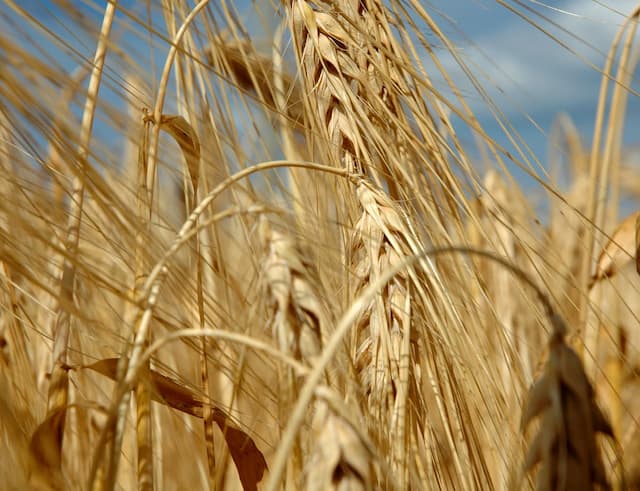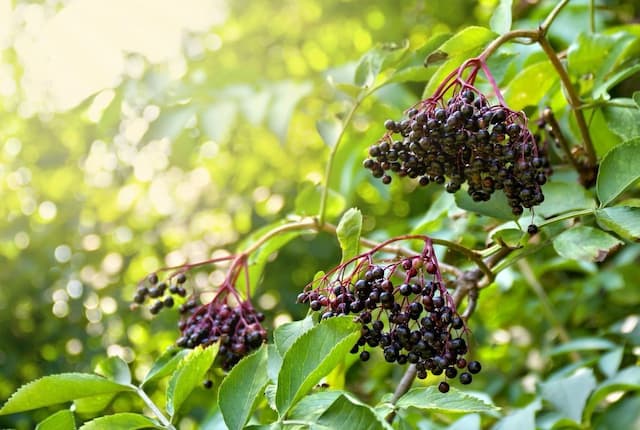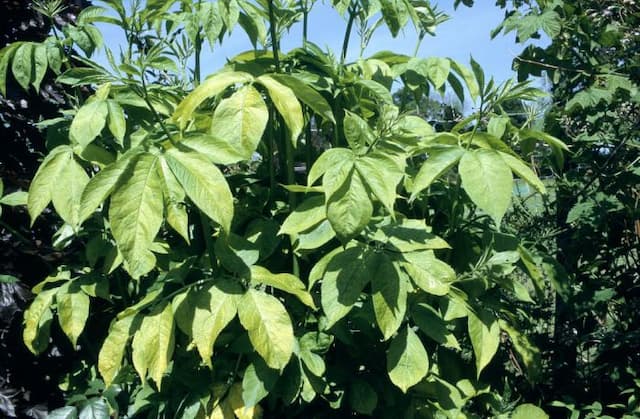Golden Variegated Elderberry Sambucus nigra 'Aureomarginata' (v)

ABOUT
The Golden Elderberry is an ornamental shrub that presents a striking addition to the garden due to its distinct foliage and flower characteristics. The standout feature of this variety is its leaves, which are variegated with a combination of deep green centers and golden yellow margins. The contrast between these two colors adds a luminous quality to the foliage, giving the appearance of a glowing effect that can brighten up any garden space. In the spring and early summer, the Golden Elderberry produces large clusters of tiny cream-colored flowers. These flowers have a delicate fragrance and are arrayed in broad, flat-topped bunches known as corymbs, which attract a variety of pollinators, including bees and butterflies. After the flowering period, the plant produces clusters of small, dark berries that can attract birds and other wildlife, adding to the biodiversity of the garden environment. Overall, the Golden Elderberry is recognized for its variegated leaves and the seasonal interest it brings, offering multi-faceted beauty throughout its flowering and fruiting seasons.
About this plant
 Names
NamesFamily
Adoxaceae.
Synonyms
Golden Variegated Elder, Variegated Black Elderberry, Variegated Elder.
Common names
Sambucus nigra 'Aureomarginata' (v).
 Toxicity
ToxicityTo humans
The common name of Sambucus nigra 'Aureomarginata' is Elderberry. Parts of the elderberry plant are poisonous to humans, particularly the leaves, twigs, seeds, and unripe berries, as they contain cyanogenic glycosides which can release cyanide, a potent toxin. Ingesting these parts of the plant can lead to symptoms such as nausea, vomiting, diarrhea, abdominal pain, and in severe cases, can result in more serious consequences such as respiratory distress, seizures, and even coma. Cooking properly can destroy the glycosides in the berries, making them safe to consume when ripe.
To pets
Elderberry is also toxic to pets for the same reasons it is toxic to humans. The cyanogenic glycosides can cause similar symptoms in pets, such as vomiting, diarrhea, abdominal pain, and can be potentially fatal if consumed in large quantities. It's important to keep pets away from elderberry plants, particularly from the leaves, twigs, seeds, and unripe berries, to prevent accidental poisoning.
 Characteristics
CharacteristicsLife cycle
Perennials
Foliage type
Deciduous
Color of leaves
Variegated
Flower color
Cream
Height
6-10 feet (1.8-3 m)
Spread
6-10 feet (1.8-3 m)
Plant type
Shrub
Hardiness zones
5
Native area
Europe
Benefits
 General Benefits
General Benefits- Attractive Foliage: Sambucus nigra 'Aureomarginata', also known as Variegated Elderberry, features eye-catching golden-edged leaves that add color and interest to the garden.
- Wildlife Habitat: Variegated Elderberry provides shelter and nesting sites for birds and other wildlife.
- Edible Fruit: The plant produces elderberries that can be used to make jams, jellies, and wines, though they should be cooked before consuming to remove toxic compounds.
- Fast Growth: Variegated Elderberry is a fast-growing shrub, quickly creating structure and filling spaces in the landscape.
- Drought Resistance: Once established, the Variegated Elderberry is relatively drought-resistant, requiring less water compared to some other plants.
- Pollinator Friendly: The flowers attract pollinators like bees and butterflies, enhancing pollination in the garden.
- Screening Plant: Its dense foliage makes it an excellent choice for use as a natural screen or hedge to provide privacy.
- Seasonal Interest: Variegated Elderberry provides seasonal interest with its flowers in spring and berries in summer, adding to the garden's aesthetic value across seasons.
- Low Maintenance: Aside from occasional pruning, the Variegated Elderberry is relatively low maintenance, making it an easy addition to the garden for gardeners of all skill levels.
 Medical Properties
Medical Properties- Immune support: Contains high levels of vitamin C and antioxidants, which may support the immune system.
- Respiratory health: Traditionally used to treat colds, influenza, and other respiratory issues due to its expectorant properties.
- Anti-inflammatory: May have anti-inflammatory effects, which can help reduce swelling and pain.
- Antiviral properties: Some studies suggest that elderberry extracts might inhibit the replication of certain viruses.
- Diuretic: Traditionally used as a diuretic, helping with urine flow and reduction of fluid retention.
- Laxative: Has been used to help with constipation due to its laxative properties.
- Antioxidant: Rich in antioxidants, which can help protect cells from damage caused by free radicals.
 Air-purifying Qualities
Air-purifying QualitiesThis plant is not specifically known for air purifying qualities.
 Other Uses
Other Uses- The elderberry can be used in the craft of dye making, where the berries provide a natural source of purple or blue dye for textiles.
- Green elderberry branches can be used to make simple garden plant stakes, being strong enough when young to support small plants.
- The hollowed-out branches of elderberry can be turned into flutes or whistles by those knowledgeable in traditional woodcraft.
- Berries from the elderberry plant can be used as a natural food coloring in baking, adding a reddish-purple hue to pastries and desserts.
- Elderberry wood is soft and easily carved, making it suitable for crafting small items such as spoons or decorative ornaments.
- The flowers from Sambucus nigra can be dipped in a light batter and fried to make a sweet and aromatic elderflower fritter, a unique culinary treat.
- Due to its fast growth, elderberry can be used in permaculture as a ‘nurse plant’, providing shelter and improving the microclimate for more sensitive plants.
- Leaves from the elderberry can be added to compost heaps, where their high nitrogen content helps speed up the composting process.
- Elderberry branches are sometimes fashioned into simple jewelry such as necklaces or bracelets by drying and threading the hollow stems.
- When trimmed and dried, elderberry twigs can be woven into baskets or used in other forms of traditional wickerwork.
Interesting Facts
 Feng Shui
Feng ShuiThe European Elderberry is not used in Feng Shui practice.
 Zodiac Sign Compitability
Zodiac Sign CompitabilityThe European Elderberry is not used in astrology practice.
 Plant Symbolism
Plant Symbolism- Elder: Sambucus nigra 'Aureomarginata', commonly known as Elder, symbolizes protection due to a long-standing belief that the plant wards off evil spirits. In folklore, it was often planted near homes for this purpose.
- Elder: Represents wisdom and longevity, as elders are often associated with knowledge accrued over years and elder plants can live for many years.
- Elder: Symbolizes transformation and renewal because the elder tree is known to easily regenerate from damage and can also be used to produce rejuvenating elderflower and elderberry products.
- Elder: Is associated with the fairy realm and magic, which stems from various mythologies where the elder tree is considered a conduit between different worlds or a favorite of fairies.
 Water
WaterThe Golden Elderberry should be watered deeply and thoroughly to ensure the water reaches the root zone, approximately once a week during the growing season. In times of drought or extreme heat, you may need to water it twice a week. Always check the soil moisture before watering; it should be moist but not waterlogged. During the winter months when the plant is dormant, reduce the frequency to only when the soil is dry to the touch. As a general rule of thumb, aim to provide about 1 to 1.5 gallons of water each time for an established plant.
 Light
LightThe Golden Elderberry thrives in full sun to partial shade. Ideally, it should receive at least six hours of sunlight each day, though some afternoon shade can be beneficial in hotter climates. The best spot for this plant would be an area that gets morning sunlight and dappled or partial shade in the afternoon to protect its leaves from scorching.
 Temperature
TemperatureThe Golden Elderberry can tolerate a wide range of temperatures but prefers conditions between 60°F and 75°F during the growing season. It is hardy and can survive winter temperatures as low as -20°F. During the summer, the plant can handle temperatures up to 95°F, but ensure it has adequate water during hotter periods to prevent stress.
 Pruning
PruningPrune the Golden Elderberry to maintain its shape and size and encourage the growth of new shoots, which is where flowers and fruits will appear. The best time to prune is late winter or early spring before new growth starts. Thin out any dead or crowded branches and cut back the plant by about a third every few years to rejuvenate it.
 Cleaning
CleaningAs needed
 Soil
SoilFor Golden Variegated Elderberry, a well-draining soil mix is crucial, ideally with loam and organic matter. The soil pH should be between 5.5 to 6.5 for optimal growth.
 Repotting
RepottingGolden Variegated Elderberry, typically planted outdoors, requires no repotting. In containers, young plants may need yearly repotting to accommodate growth.
 Humidity & Misting
Humidity & MistingGolden Variegated Elderberry tolerates a range of humidity levels and does not have specific humidity requirements, thriving in outdoor conditions.
 Suitable locations
Suitable locationsIndoor
Provide bright light and space; not ideal for indoor growth.
Outdoor
Plant in well-draining soil, full sun to partial shade.
Hardiness zone
4-7 USDA
 Life cycle
Life cycleSambucus nigra 'Aureomarginata', commonly known as the Golden Variegated Elderberry, starts its life cycle when seeds germinate in spring after stratification. The seedlings develop into juvenile plants featuring green serrated leaves with golden-yellow margins. As the plant matures, it enters a rapid vegetative growth phase, forming a deciduous shrub or small tree with arching branches. Throughout late spring to early summer, it produces flat-topped clusters of creamy, fragrant flowers that attract pollinators, followed by the formation of small black or dark purple berries by late summer or autumn, which are dispersed by birds and other wildlife. In autumn, the leaves turn a variety of colors before dropping, with the plant entering dormancy during winter months. Each year, the elderberry can sprout new canes from its base, slowly expanding in size with some canes dying back, creating a cycle of renewal within the plant's lifespan.
 Propogation
PropogationPropogation time
Early Spring
The European black elderberry 'Aureomarginata' is a variegated cultivar of Sambucus nigra that is propagated primarily by softwood cuttings. The best time to take these cuttings is in late spring to early summer when new growth is mature enough, yet still has some flexibility. To propagate by cuttings, a section of the softwood stem about 4-6 inches (10-15 cm) long is cut just below a leaf node. The lower leaves are removed, and the cut end is often dipped in a rooting hormone powder to encourage root formation. The prepared cutting should then be inserted into a moist, well-draining potting medium and kept at a consistent humidity level by covering it with a plastic bag or a propagator. Roots usually develop within 4 to 8 weeks, after which the new plants can be gradually acclimatized to outdoor conditions before being planted out in their final location.



![Elder [Black Tower]](/_next/image?url=https%3A%2F%2Fplants-admin.emdemapps.com%2Fimages%2Fplants%2F%2Fimages%2F604b5cad99578.png&w=640&q=75)





